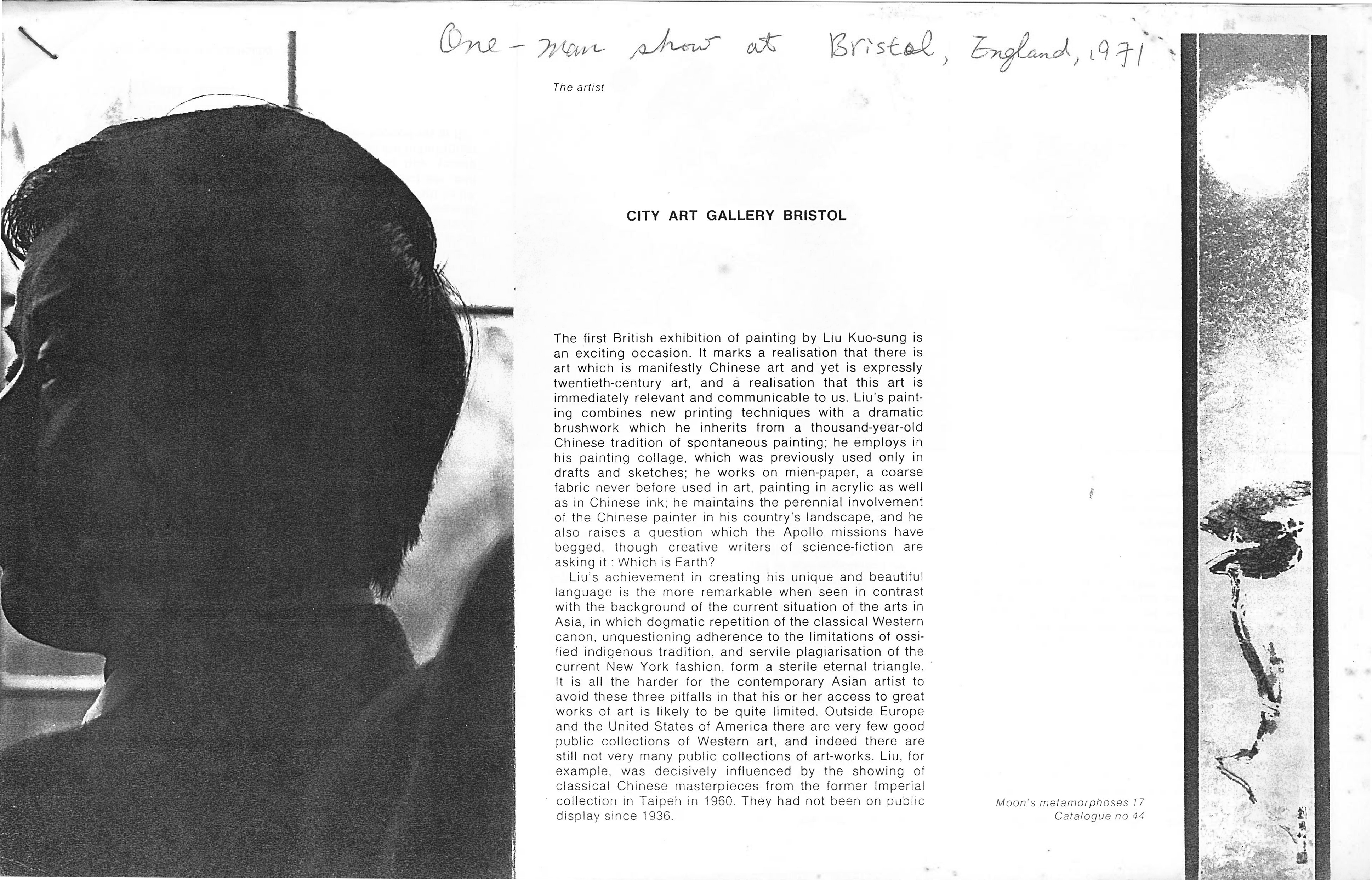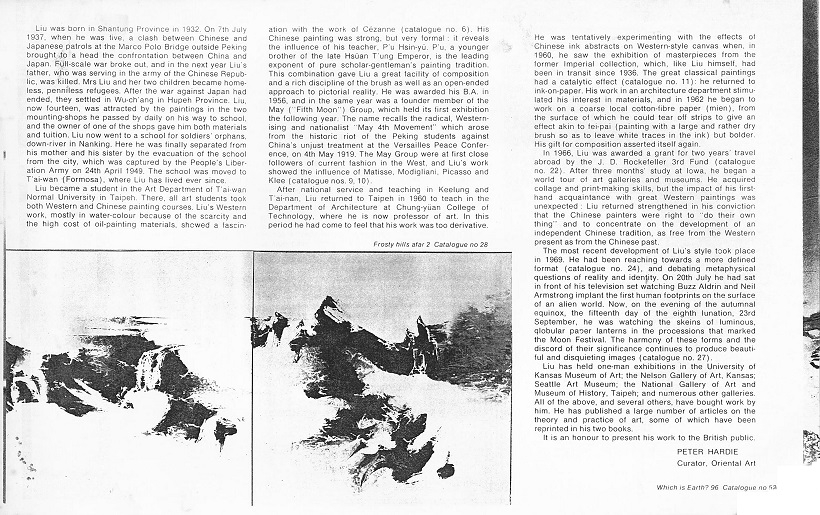CITY ART GALLERY BRISTOL
- 期刊與書籍
- Peter Hardie
- 1971.9
The first British exhibition of painting by Liu Kuo-sung is an exciting occasion. It marks a realization that there is art which is manifestly Chinese art and yet is expressly twentieth-century art, and a realization that this art is immediately relevant and communicable to us. Liu’s painting combines new printing techniques with a dramatic brushwork which he inherits from a thousand-year-old Chinese tradition of spontaneous painting; he employs in his painting collage, which was previously used only drafts and sketches; he works on mien-paper, a coarse fabric never before used in art, painting in acrylic as well as in Chinese ink; he maintains the perennial involvement of the Chinese painter in his country’s landscape, and he also raises a question which the Apollo missions have begged, though creative writers of science-fiction are asking it: Which is Earth?
Liu’s achievement in creating his unique and beautiful language is the more remarkable when seen in contrast with the background of the current situation of the arts in Asia, in which dogmatic repetition of the classical Western canon, unquestioning adherence to the limitations of ossified indigenous tradition, and servile plagiarisation of the current New York fashion, form a sterile eternal triangle. It is all the harder for the contemporary Asian artist to avoid these three pitfalls in that his or her access to great works of art is likely to be quite limited. Outside Europe and the United States of America there are very few good public collections of Western art, and indeed there are still not very many public collections of art-works. Liu, for example, was decisively influenced by the showing of classical Chinese masterpieces from the former Imperial collection in Taipei in 1960. They had not been on public display since 1936.
Liu was born in Shantung Province in 1932. On 7th July 1937, when he was five, a clash between Chinese and Japanese patrols at the Marco Polo Bridge outside Peking brought to a head the confrontation between China and Japan. Full-scale war broke out, and in the next year Liu’s father, who was serving in the army of the Chinese Republic, was killed. Mrs. Liu and her two children became homeless, penniless refugees. After the war against Japan had ended, they settled in Wu-ch’ang in Hubei Province. Liu, not fourteen, was attracted by the paintings in the two mounting-shops he passed by daily on his way to school, and the owner of one of the shops gave him both materials and tuition. Liu now went to a school for soldier’s orphans, down-river in Nanking. Here he was finally separated from his mother and his sister by the evacuation of the school from the city, which was captured by the People’s Liberation Army on 24th April 1949. The school was moved to Taiwan (Formosa), where Liu has lived ever since.
Liu became a student in the Art Department of Taiwan Normal University in Taipei. There, all art students took both Western and Chinese painting courses. Liu’s Western work, mostly in water-colour because of the scarcity and the high cost of oil-painting materials, showed a fascination with the work of Cezanne. His Chinese painting was strong, but very formal: it reveals the influence of his teacher, P’u Hsin-yu. P’u, a younger brother of the late Hsuan T’ung Emperor, is the leading exponent of pure scholar-gentleman’s painting tradition. This combination gave Liu a great facility of composition and a rich discipline of the brush as well as an open-ended approach to pictorial reality. He was awarded his B.A. in 1956, and in the same year was a founder member of the May (“Fifth Moon”) Group, which held its first exhibition the following year. The name recalls the radical, Westernising and nationalist “May 4th Movement” which arose from the historic riot o the Peking students against China’s unjust treatment at the Versailles Peace Conference, on 4th May 1919. The May Group was at first close followers of current fashion in the West, and Liu’s work showed the influence of Matisse, Modigliani, Picasso and Klee.
After national service and teaching in Keelung and Tainan, Liu returned to Taipei in 1960 to teach in the Department of Architecture at Chung-yuan College of Technology, where he is now professor of art. In this period he had come to feel that his work was too derivative. He was tentatively experimenting with the effects of Chinese ink abstracts on Western-style canvas when, in 1960, he saw the exhibition of masterpieces from the former Imperial collection, which, like Liu himself had been in transit since 1936. The great classical paintings had a catalytic effect: he returned to ink-on-paper. His work in an architecture department stimulated his interest in coarse local cotton-fibre paper (mien), from the surface of which he could tear off trips to give an effect akin to fei-pai (painting with a large and rather dry brush so as to leave white traces in the ink) but bolder. His gift for composition asserted itself again.
In 1966, Liu was awarded a grant for two years travel abroad by the J.D. Rockefeller 3rd Fund. After three months’ study at Iowa, he began a world tour of art galleries and museums. He acquired collage and print-making skills, but the impact of his first-hand acquaintance with great Western paintings was unexpected: Liu returned strengthened in his conviction that the Chinese painters were right to “do their own thing” and to concentrate on the development of an independent Chinese tradition, as free from the Western present as from the Chinese past.
The most recent development of Liu’s style took place in 1969. He had been reaching towards a more defined format, and debating metaphysical questions of reality and identity. On 20th July he had sat in front of his television set watching Buzz Aldrin and Neil Armstrong implant the first human footprints on the surface of an alien world. Now, on the evening of the autumnal equinox, the fifteenth day of the eighth lunation, 23rd September, he was watching the skeins of luminous, globular paper lanterns in the procession that marked the Moon Festival. The harmony of these forms and the discord of their significance continues to produce beautiful and disquieting images.
Liu has held one-man exhibitions in the University of Kansas Museum of Art; the Nelson Gallery of Art, Kansas; Seattle Art Museum; the National Gallery of Art and Museum of History, Taipei; and numerous other galleries. All of the above, and several others, have bought work by him. He has published a large number of articles on the theory and practice of art, some of which have been reprinted in his two books.
It is an honour to present his work to the British public.
Peter Hardie
Curator, Oriental Art

